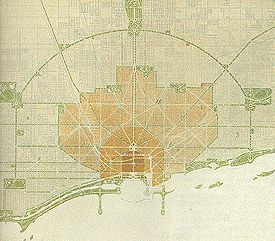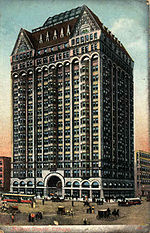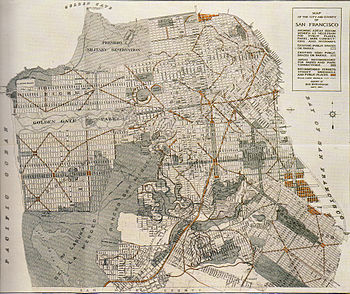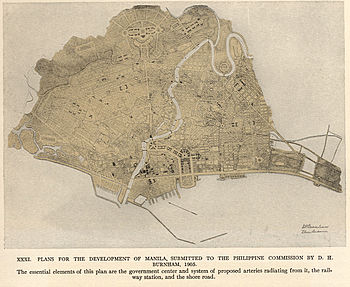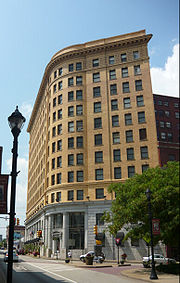- Daniel Burnham
-
Daniel Burnham 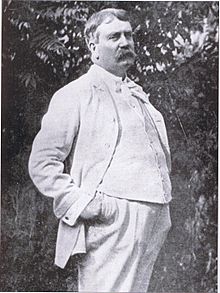
Born September 4, 1846
Henderson, New YorkDied June 1, 1912 (aged 65)
Heidelberg, GermanyNationality American Work Practice Burnham and Root Buildings Flatiron Building, Union Station (Washington, D.C.), Postal Square Building Projects World's Columbian Exposition Daniel Hudson Burnham, FAIA (September 4, 1846 – June 1, 1912) was an American architect and urban planner. He was the Director of Works for the World's Columbian Exposition in Chicago. He took a leading role in the creation of master plans for the development of a number of cities, including Chicago and downtown Washington DC. He also designed several famous buildings, including the Flatiron Building in New York City and Union Station in Washington D.C.
Contents
Biography
Burnham was born in Henderson, New York and raised in Chicago, Illinois. His parents brought him up under the teachings of the Swedenborgian Church of New Jerusalem,[1] which ingrained in him the strong belief that man should strive to be of service to others.[2] After failing admissions tests for both Harvard and Yale, and an unsuccessful stint at politics, Burnham apprenticed as a draftsman under William LeBaron Jenney. At age 26, Burnham moved on to the Chicago offices of Carter, Drake, and Wight, where he met future business partner John Wellborn Root (1850–1891).
Burnham and Root were the architects of one of the first American skyscrapers: the Masonic Temple Building[3] in Chicago. Measuring 21 stories and 302 feet, the Temple held claims as the tallest building of its time, but was torn down in 1939. Under the design influence of Root, the firm had produced modern buildings as part of the Chicago School. Following Root’s premature death from pneumonia in 1891, the firm became known as D.H. Burnham & Company.
World's Columbian Exposition
Burnham and Root had accepted responsibility to oversee design and construction of the World's Columbian Exposition in Chicago’s then-desolate Jackson Park on the south lakefront. The largest world's fair to that date (1893), it celebrated the 400-year anniversary of Christopher Columbus' famous voyage. After Root's sudden and unexpected death, a team of distinguished American architects and landscape architects, including Burnham, Frederick Law Olmsted, Charles McKim and Louis Sullivan, radically changed Root's modern and colorful style to a Classical Revival style. Under Burnham's direction, the construction of the Fair overcame huge financial and logistical hurdles, including a worldwide financial panic and an extremely tight timeframe, to open on time.
Considered the first example of a comprehensive planning document in the nation, the fairground was complete with grand boulevards, classical building facades, and lush gardens. Often called the "White City", it popularized neoclassical architecture in a monumental and rational Beaux-Arts plan. The remaining population of architects in the U.S. were soon asked by clients to incorporate similar elements into their designs.
City planning and "The Plan of Chicago"
Initiated in 1906 and published in 1909, Burnham and his co-author Edward H. Bennett prepared "The Plan of Chicago", which laid out plans for the future of the city. It was the first comprehensive plan for the controlled growth of an American city, and an outgrowth of the City Beautiful movement. The plan included ambitious proposals for the lakefront and river and declared that every citizen should be within walking distance of a park. Sponsored by the Commercial Club of Chicago,[4] Burnham donated his services in hopes of furthering his own cause.
Plans and conceptual designs of the south lakefront[5] from the Exposition came in handy, as he envisioned Chicago being a "Paris on the Prairie". French-inspired public works constructions, fountains, and boulevards radiating from a central, domed municipal palace became Chicago's new backdrop. Though only parts of the plan were actually implemented, it set the standard for urban design, anticipating future need to control unexpected urban growth, and continued to influence the development of Chicago long after Burnham's death.
City planning projects did not stop at Chicago though. Burnham contributed to plans for cities such as Cleveland (the Group Plan), San Francisco, and Manila and Baguio in the Philippines, details of which appear in "The Chicago Plan" publication of 1909. His plans for the redesign of San Francisco were delivered to City Hall on April 17, 1906, the day before the 1906 earthquake. In the haste to rebuild the city, the plans were ultimately ignored. The Plan for Manila was not fulfilled, except for a shore road, which became Dewey boulevard, now known as Roxas boulevard.
In Washington, D.C., Burnham did much to shape the McMillan Plan, which led to the completion of the overall design of the National Mall. Going well beyond Pierre L'Enfant's original vision for the city, the plan provided for the extension of the Mall beyond the Washington Monument to a new Lincoln Memorial and a "pantheon" that eventually materialized as the Jefferson Memorial. Inter alia, this involved significant reclamation of land from swamp and the Potomac River, and the relocation of an existing railroad station on the site, which was replaced by Burnham's own design for Union Station.[6]
Influence
Much of his career work modeled the classical style of Greece and Rome. In his 1924 autobiography, Louis Sullivan, one of the leading architects from the Chicago School but one who had enjoyed difficult relations with Burnham over an extended period, criticised Burnham for what Sullivan viewed as his lack of original expression and dependence on Classicism.[7] Sullivan went on to claim that "the damage wrought by the World's Fair will last for half a century from its date, if not longer"[8]—a sentiment edged with bitterness, as corporate America of the early twentieth century had demonstrated a strong preference for Burnham's architectural style over Sullivan's.
Burnham was quoted after his death as saying, "Make no little plans. They have no magic to stir men's blood and probably will not themselves be realized." (Moore 1921) This slogan has been taken to capture the essence of Burnham's spirit, although there is no documented evidence that he actually used those words.
A man of influence, Burnham was considered the preeminent architect in America at the turn of the twentieth century. He held many positions during his lifetime, including the presidency of the American Institute of Architects.[9] Other notable architects began their careers under his aegis, such as Joseph W. McCarthy. In 1912, when he died in Heidelberg, Germany, D.H. Burnham and Co. was the world's largest architectural firm. Even legendary architect Frank Lloyd Wright, although strongly critical of Burnham's Beaux Arts European influences still admired him as a man, eulogized: "(Burnham) made masterful use of the methods and men of his time... (as) an enthusiastic promoter of great construction enterprises... his powerful personality was supreme." His firm continues its work today under the name Graham, Anderson, Probst & White, which it adopted in 1917.
Memorials
Almost as a tribute to his urban planning ethos, Burnham's final resting spot is given special attention, being located on the only island in the park-like Graceland Cemetery, situated in Chicago's Uptown neighborhood. Six mile long Burnham Park (Chicago) is named in his honor.
Because he was the planner and architect of Baguio City in the Philippines, the city's Burnham Park was named after him. In his honor, the American Planning Association named a major annual prize the Daniel Burnham Award for a Comprehensive Plan.[10] An alley in San Francisco, formerly Hemlock Street between Van Ness Avenue and Franklin Street, was renamed in Burnham's honor.
Collections of Burnham's personal and professional papers, photographs, and other archival materials are held by the Ryerson and Burnham Archives at the Art Institute of Chicago.
The Daniel Burnham Memorial Competition (Chicago) was held in 2009 to create a memorial to Daniel Burnham and his Plan of Chicago. Daniel Burnham Court, a building, is also named after him as is the street, Daniel Burnham Court.
Notable commissions
Philippines
- Manila
- Baguio City
- Provincial Capitol Building in Bacolod City, Negros Occidental
Chicago
- Union Stock Yard Gate
- Kent House
- Rookery Building
- Monadnock Building (northern half)
- Reliance Building
- Fisher Building
- Heyworth Building
- Marshall Field and Company Building
- Flat Iron Building (Chicago)
- Boyce Building, on the National Register of Historic Places[11][12]
Detroit
- Dime Building
- Ford Building
- David Whitney Building
- Majestic Building
Pittsburgh
- Union Trust Building 1898 (337 Fourth Avenue - Not the 1917 structure of the same name on Grant Street)
- Pennsylvania Union Station 1900-1902
- Frick Building 1902
- McCreery Department Store (now offices - 300 Sixth Avenue Building) 1904
- Highland Building 1910 (121 South Highland Avenue)
- Henry W. Oliver Building 1910
Washington, D.C.
- Union Station
- Postal Square Building
- Columbus Fountain
Others
- Flatiron Building, New York City
- Citizens Bank Financial Center, Wilkes-Barre, Pennsylvania
- Wyandotte Building, Columbus, Ohio
- Columbus Union Station of 1897
- Gilbert M. Simmons Memorial Library, Kenosha, Wisconsin.
- Ellicott Square Building, Buffalo, New York
- Pennsylvania Railroad Station, Richmond, Indiana
- Cleveland Mall with Arnold Brunner and John Carrère, 1903
- Union Station, El Paso, Texas
- First National Bank Building (now Fayette Building), Uniontown, Pennsylvania, 1902
- John Wanamaker department store (now Macy's), Philadelphia
- John Wanamaker department store, New York City
- Selfridge & Co. Department Store, London
- Filene's Department Store, Boston
- Terminal Arcade, Terre Haute, Indiana
- First National Bank Building, Milwaukee, Wisconsin
- Duluth Civic Center Historic District, Duluth, Minnesota
- Merchants Exchange Building (San Francisco)
- Miners National Bank Building - now Citizens Bank Building, Wilkes-Barre, Pennsylvania
In popular culture
- Make No Little Plans - Daniel Burnham and the American City[13] is the first feature length documentary film about noted architect and urban planner Daniel Hudson Burnham, produced by the Archimedia Workshop. National distribution in 2009 coincided with the centennial celebration of Daniel Burnham and Edward Bennett's 1909 Plan of Chicago.
- The Devil in the White City, a non-fiction book by Erik Larson, intertwines the true tale of three men: H.H. Holmes, a serial killer famed for his 'murderous hotel' in Chicago, Patrick Eugene Prendergast asassin of Chicago's Mayor Carter Harrison Sr. and Daniel Burnham.
- In the role-playing game Unknown Armies, James K. McGowan, the True King of Chicago, quotes Daniel Burnham and regards him as a paragon of the Windy City's mysterious and magical past.
- In the episode "Legendaddy" of TV sitcom How I Met Your Mother, the character Ted, who is professor of architecture, describes Burnham as an "architectural chameleon."
References
- Notes
- ^ The New Church, a Swedenborgian Faith
- ^ Carl Smith, The Plan of Chicago: Daniel Burnham and the Remaking of the American City, p. 56
- ^ "Masonic Temple, Chicago". Old Chicago in Vintage Postcards. http://patsabin.com/illinois/masonic.htm. Retrieved 2008-06-04.
- ^ "The Commercial Club of Chicago: Purpose & History". http://www.commercialclubchicago.org/purpose/. Retrieved 2008-06-04.
- ^ American Memory Digital Item Display - 2007660861
- ^ Movie: "Make No Little Plans"
- ^ Sullivan, Louis, The Autobiography of an Idea, Press of the American Institute of Architects, Inc, 1924 p. 320-21
- ^ Sullivan, Louis, The Autobiography of an Idea, Press of the American Institute of Architects, Inc, 1924 p. 325
- ^ "AIA Presidents". American Institute of Architects. http://www.aia.org/history_presidents. Retrieved 2008-06-04.
- ^ "National Planning Awards". American Planning Association. http://www.planning.org/awards/. Retrieved 2008-06-04.
- ^ "Illinois - Cook County". National Register of Historic Places. http://www.nationalregisterofhistoricplaces.com/il/Cook/state.html. Retrieved 2008-11-02.
- ^ Randall, Frank Alfred; John D. Randall. History of the Development of Building Construction in Chicago. Urbana and Chicago, Illinois: University of Illinois Press. pp. 286. ISBN 0252024168. http://books.google.com/books?id=gYLlF61yeYEC&pg=PA286&lpg=PA286&dq=%22boyce+building%22+history+500&ct=result#PPA286,M1. Retrieved 2008-11-02.
- ^ "Daniel Burnham Film". The Archimedia Workshop. http://www.thearchimediaworkshop.org. Retrieved 2009-04-06.
- Bibliography
- Moore, Charles (1921). "XXV "Closing in 1911–1912"". Daniel H. Burnham, Architect, Planner of Cities, Volume 2. Boston, Massachusetts: Houghton Mifflin. pp. 1921.
- Larson, Erik (February 2003). The Devil in the White City: Murder, Magic and Madness at the Fair that Changed America. New York, New York: Crown Publishers. ISBN 0-609-60844-4.
- Stolze, Greg (February 2002). Unknown Armies. St Paul, MN: Atlas Games. ISBN 1-58978-013-2.
- Burnham, Daniel H., and Edward H. Bennett, Plan of Chicago, the Commercial Club, Chicago MCMIX
- "Daniel Burnham". Chicago Landmarks. http://www.ci.chi.il.us/Landmarks/Architects/Burnham.html. Retrieved September 21, 2004.
- "Daniel Hudson Burnham". Chicago Stories. Archived from the original on August 21, 2004. http://web.archive.org/web/20040821054508/http://www.wttw.com/chicagostories/burnham.html. Retrieved September 24, 2004.
- Jameson, D. "Daniel Hudson Burnham". Artists Represented. http://www.architechgallery.com/arch_info/artists_pages/daniel_burnham_bio.html. Retrieved December 14, 2005.
- "Today In History: September 4". American Memory. The Library of Congress. http://memory.loc.gov/ammem/today/sep04.html. Retrieved September 24, 2004.
External links
Categories:- American architects
- Fellows of the American Institute of Architects
- American urban planners
- People from Chicago, Illinois
- People from Jefferson County, New York
- American expatriates in the Philippines
- American Swedenborgians
- Burials at Graceland Cemetery (Chicago)
- 1846 births
- 1912 deaths
- Western Association of Architects
- World's Columbian Exposition
Wikimedia Foundation. 2010.


